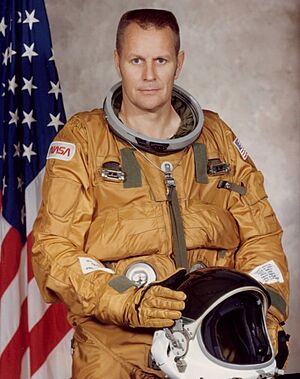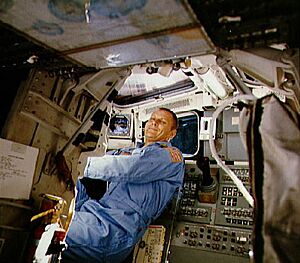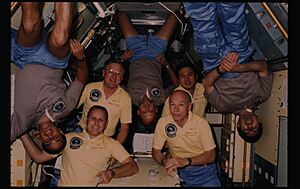Robert F. Overmyer facts for kids
Quick facts for kids
Robert F. Overmyer
|
|
|---|---|

Overmyer in his spacesuit in 1982
|
|
| Born |
Robert Franklyn Overmyer
July 14, 1936 Lorain, Ohio, U.S.
|
| Died | March 22, 1996 (aged 59) Duluth, Minnesota, U.S.
|
| Awards | Distinguished Flying Cross |
| Space career | |
| NASA astronaut | |
| Rank | Colonel, USMC |
|
Time in space
|
12d 2h 22m |
| Selection | USAF MOL Group 2 (1966) NASA Group 7 (1969) |
| Missions | STS-5 STS-51-B |
|
Mission insignia
|
|
| Retirement | June 1986 |
Robert Franklyn "Bob" Overmyer (July 14, 1936 – March 22, 1996) was an American test pilot, naval aviator, and NASA astronaut. He was also a Marine Corps officer. Overmyer was first chosen by the Air Force to be an astronaut in 1966. When that program ended, he joined NASA in 1969. He helped with the Apollo program and Skylab missions. Later, he flew two Space Shuttle missions: STS-5 as a pilot in 1982 and STS-51-B as commander in 1985. After the Challenger disaster in 1986, he helped investigate what happened. He retired from NASA that same year. Robert Overmyer died ten years later while testing a homebuilt aircraft.
Contents
Early Life and Education
Robert Overmyer was born in Lorain, Ohio, on July 14, 1936. He grew up in Westlake, Ohio. As a young person, he was active in the Boy Scouts of America. He reached the rank of First Class Scout.
He finished high school in 1954. In 1958, he earned a degree in physics from Baldwin–Wallace College. He then studied at the U.S. Naval Postgraduate School. In 1964, he received a master's degree in aeronautical engineering.
Career as a Pilot
Joining the Marine Corps
Overmyer joined the Marine Corps in January 1958. He completed his Navy flight training in Texas. After that, he flew with a Marine squadron. In 1962, he went back to school to study aeronautical engineering.
He later attended the U.S. Air Force Test Pilot School in California. In 1966, he was chosen to be an astronaut for a special Air Force program. This program was called the Manned Orbiting Laboratory (MOL).
Overmyer was a very experienced pilot. He flew for over 7,500 hours. More than 6,000 of those hours were in jet aircraft.
Becoming a NASA Astronaut
The MOL program was canceled in 1969. After that, Overmyer became a NASA astronaut. His first job at NASA was working on the Skylab program from 1969 to 1971.
He also helped with the Apollo 17 mission. He was a support crew member and the voice of mission control during launch. From 1973 to 1975, he supported the Apollo-Soyuz Test Project. He was NASA's voice in the mission control center in Moscow.
In 1976, he started working on the Space Shuttle program. He was a main chase pilot for the shuttle's landing tests. In 1979, he helped prepare the Space Shuttle Columbia for its first flight. He made sure its parts and tiles were ready.
Flying the Space Shuttle
STS-5 Mission
Overmyer was the pilot for STS-5. This was the first full working flight of the Space Shuttle. It launched from Kennedy Space Center, Florida, on November 11, 1982. He flew with commander Vance D. Brand and two other astronauts.
This mission was the first to have a four-person crew. They successfully launched two satellites from the shuttle's cargo bay. This showed that the shuttle was ready for regular use. The crew also performed many tests to check the shuttle's performance.
The STS-5 mission lasted five days. It landed on a concrete runway at Edwards Air Force Base, California. This landing happened on November 16, 1982.
STS-51-B Mission
Overmyer was the commander of STS-51-B. This mission was called Spacelab-3 (SL-3). He led a crew of four astronauts and two payload specialists. They did many science experiments in space. These experiments covered space physics and how animals live in space.
STS-51-B also launched a small payload from a special container. The mission launched on April 29, 1985, from Kennedy Space Center. It landed on May 6, 1985, at Edwards Air Force Base. The shuttle completed 110 orbits of Earth.

In 1986, Overmyer helped investigate the Challenger disaster. He was one of NASA's main investigators for the accident.
Overmyer retired from NASA and the Marine Corps in May 1986.
After NASA
After leaving NASA, Overmyer started his own business. He worked as a consultant for aerospace companies. He also wrote articles for a British magazine. In 1988, he joined McDonnell Douglas Aerospace. He worked there for seven years on the Space Station team.
He retired from McDonnell Douglas in 1995. He then focused on his consulting work. He also gave speeches and continued writing.
Test Pilot Work
Overmyer kept working as a general aviation test pilot. He had experience from the Air Force and NASA. In 1995, he joined Cirrus Design, an aircraft company. He helped test their first plane, the Cirrus VK-30.
He also worked on testing the Cirrus SR20. This plane was certified in 1998. It helped introduce new technologies like glass cockpits and ballistic parachutes to small planes.
Death and Family

Robert Overmyer died in a plane crash on March 22, 1996. The crash happened near the Duluth International Airport. He was testing the VK-30 plane at the time. The plane lost control during a test.
He was buried at Arlington National Cemetery. He was survived by his wife, Katherine, and their three children.
Awards and Honors
Overmyer was a member of several important aviation groups. These included the Society of Experimental Test Pilots.
He received many awards for his service:
- The Air Force Meritorious Service Medal in 1969.
- The Marine Corps Meritorious Service Medal in 1978.
- An Honorary Doctor of Philosophy degree in 1982.
- The U.S. Naval Postgraduate School Distinguished Engineers Award in 1983.
- The Distinguished Flying Cross in 1983.
- The NASA Space Flight Medal in 1983.
There is an Ohio Historical Marker in Clague Park, Westlake, Ohio. It honors his life and career.
Images for kids
See also





